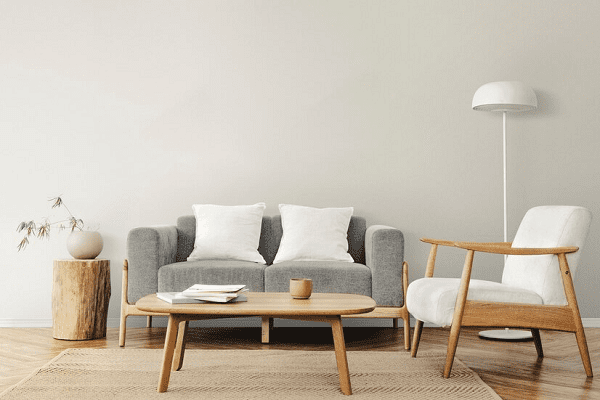Furniture- Furniture refers to movable objects and fixtures that are designed to support various human activities such as sitting, sleeping, storage, and more. It is an essential part of interior design and plays a significant role in shaping the functionality and aesthetics of living spaces. Furniture can be made from a wide range of materials, including wood, metal, plastic, glass, and more, and it comes in various styles and designs to suit different preferences and needs.
Common types of furniture include:
- Seating Furniture: This category includes items like sofas, chairs, recliners, benches, and stools. Seating furniture is designed for sitting and provides comfort and support.
- Tables: Tables come in various forms, including dining tables, coffee tables, side tables, and desks. They serve as surfaces for various activities such as dining, working, and socializing.
- Storage Furniture: These pieces are designed to store and organize belongings. Common examples are dressers, wardrobes, cabinets, bookshelves, and entertainment centers.
- Beds: Beds are designed for sleeping and come in various sizes, including single, twin, double, queen, and king. They are often paired with mattresses for added comfort.
- Outdoor Furniture: These pieces are designed for use in outdoor spaces, such as gardens, patios, and balconies. Common examples include outdoor tables and chairs, hammocks, and lounge furniture.
- Modular Furniture: This type of furniture is designed with flexibility in mind. It often consists of individual pieces that can be combined and rearranged to create different configurations.
- Children’s Furniture: Furniture designed for children, including cribs, changing tables, and small-sized chairs and tables.
- Accent Furniture: These are decorative pieces used to add character and style to a room. Examples include accent tables, decorative chests, and unique chairs.
- Office Furniture: Designed for use in a workspace, office furniture includes desks, office chairs, filing cabinets, and conference tables.
- Specialty Furniture: Some pieces are designed for specific purposes, such as hospital beds, restaurant booths, and salon chairs.
The choice of furniture depends on factors like the intended use, available space, style preferences, and budget. High-quality furniture can last for many years and contribute to the overall comfort and aesthetics of a home or other space. It’s important to consider factors like material, design, and durability when selecting furniture to ensure it meets your needs and complements the decor of the space.
What is Furniture
Furniture is a term that encompasses a wide range of movable objects and fixtures designed to support various human activities within living spaces, workplaces, and other environments. These objects are typically used for sitting, sleeping, storing items, working, or other purposes. Furniture is a fundamental component of interior design and has a significant impact on the functionality and aesthetics of a space.
Common examples of furniture include:
- Seating Furniture: This category includes chairs, sofas, recliners, stools, and benches, among others. Seating furniture is designed to provide a comfortable place to sit.
- Tables: Tables come in various forms, such as dining tables, coffee tables, desks, and side tables. They serve as surfaces for activities like dining, working, and holding items.
- Storage Furniture: Pieces like wardrobes, dressers, cabinets, bookshelves, and storage ottomans are designed to store and organize various belongings.
- Beds: Beds are specifically designed for sleeping and come in different sizes, including single, twin, double, queen, and king. They are often paired with mattresses for comfort.
- Outdoor Furniture: Outdoor furniture is designed for use in open-air spaces like gardens, patios, and decks. Common examples include outdoor tables, chairs, lounges, and hammocks.
- Modular Furniture: These pieces are versatile and can be reconfigured and rearranged as needed. They often consist of modular components that can be combined to create different layouts.
- Children’s Furniture: This category includes furniture designed for kids, such as cribs, changing tables, small-sized chairs, and tables.
- Accent Furniture: Accent furniture pieces are used for decorative purposes and to add style and character to a room. Examples include accent tables, decorative chests, and unique chairs.
- Office Furniture: Office furniture is specifically designed for workspaces and includes items like desks, office chairs, filing cabinets, and conference tables.
The materials used in furniture construction can vary widely, including wood, metal, plastic, glass, and more. Furniture comes in various styles and designs to suit different preferences and needs, and it plays a crucial role in creating a comfortable and functional environment.
When selecting furniture, people consider factors such as the intended use, available space, personal style, and budget. High-quality furniture can last for many years and enhance the overall comfort and aesthetics of a space.
Who is Required Furniture
“Required Furniture” is not a specific individual or entity. The term “required furniture” simply refers to the furniture that is necessary or essential for a particular purpose, such as furnishing a home, office, or any other space. The specific furniture items needed can vary greatly depending on the context and the requirements of the space.
For example, if someone is moving into a new apartment, the required furniture might include a bed, sofa, dining table, chairs, and storage furniture like dressers or cabinets. In an office setting, required furniture typically includes desks, chairs, filing cabinets, and conference tables.
The specific furniture requirements will depend on the intended use of the space and the individual or organizational needs. There is no one entity or person known as “Required Furniture.” Instead, it’s a concept related to the necessary furniture items for a particular situation.
When is Required Furniture

The phrase “required furniture” does not specify a particular time or date. It’s a general term used to describe the furniture that is needed or essential for a particular purpose or situation. When you refer to “required furniture,” you are discussing the furniture items that are necessary to fulfill the functional and aesthetic needs of a space.
The timing for acquiring required furniture depends on various factors, including:
- Moving into a New Home or Office: When you move into a new living space or workspace, you will need to acquire the required furniture before or shortly after occupying the space. This timing depends on your moving schedule.
- Renovation or Redesign: If you’re renovating or redesigning a space, the timing for acquiring required furniture will depend on the progress of the renovation project.
- Changing Needs: Your furniture needs may change over time due to life events like starting a family, downsizing, or rearranging rooms. In these cases, you may acquire the required furniture as needed.
- Special Occasions or Events: For special events, such as weddings, parties, or conferences, you might acquire or rent specific furniture for a limited period based on the event date.
- Replacing Old Furniture: When existing furniture becomes damaged, outdated, or no longer suits your needs, you may need to acquire new furniture as a replacement. The timing for this depends on when the old furniture needs to be replaced.
In summary, “required furniture” is a term used to describe essential furniture items for a given purpose or situation. The timing for acquiring such furniture depends on the specific circumstances and needs of the individual or organization.
Where is Required Furniture
The location of “required furniture” depends on the specific context or purpose for which the furniture is needed. Furniture can be found in various locations, including:
- Homes: Most people have furniture in their homes to create comfortable and functional living spaces. This includes the living room, bedroom, dining room, kitchen, and other areas of the house.
- Offices: Offices and workplaces are equipped with office furniture, such as desks, chairs, file cabinets, and conference tables, to support work-related activities.
- Retail Stores: Furniture stores, department stores, and home improvement stores sell a wide range of furniture for customers to purchase.
- Online Retailers: Many people purchase furniture from online retailers, which offer a vast selection and the convenience of shopping from home.
- Rental Companies: For special events or short-term needs, rental companies provide furniture for parties, weddings, and conferences.
- Hotels and Hospitality: Hotels and hospitality establishments have furniture in guest rooms, lobbies, restaurants, and other public areas.
- Restaurants and Cafes: These businesses have furniture like tables, chairs, and booths for customers to dine or relax.
- Schools and Educational Institutions: Schools and universities use furniture like desks, chairs, and tables in classrooms and libraries.
- Healthcare Facilities: Hospitals and clinics have specialized healthcare furniture for patient rooms, waiting areas, and treatment areas.
- Public Spaces: Public parks, airports, and transportation hubs often feature public seating and benches.
The location of required furniture varies depending on its intended use and the specific setting. Whether it’s in a residential setting, a commercial space, or a public area, furniture plays a crucial role in providing comfort and functionality for various activities and purposes.
How is Required Furniture
The quality and condition of “required furniture” can vary widely depending on factors such as the type of furniture, its purpose, and individual preferences. Here are some aspects to consider when assessing how required furniture should be:
- Functionality: Required furniture should serve its intended function effectively. For example, a comfortable sofa should provide a suitable seating and lounging experience, a desk should offer an ergonomic workspace, and a dining table should be conducive to meals.
- Quality: The quality of furniture is crucial. Well-constructed furniture made from durable materials tends to last longer and offer better performance. Check for factors like the type of wood, upholstery fabric, and construction methods to assess quality.
- Comfort: Furniture meant for sitting or sleeping should be comfortable. This includes considering factors like cushioning, support, and ergonomics.
- Aesthetics: The appearance of furniture is important, especially in residential settings and places where aesthetics matter. Furniture should align with the overall design and style of the space.
- Durability: In high-traffic areas or spaces where the furniture will see heavy use, durability is essential. Durable furniture can withstand wear and tear over time.
- Size and Fit: Furniture should be appropriately sized for the space. It should not overcrowd or leave too much empty space. Consider the dimensions and layout of the room.
- Maintenance and Cleaning: Consider how easy it is to clean and maintain the furniture. Some materials and finishes are more resistant to stains and damage than others.
- Budget: The cost of furniture is a significant factor. It’s essential to find furniture that fits within your budget while meeting your requirements for quality and functionality.
- Environmental Considerations: Some people prefer eco-friendly or sustainable furniture options. Look for certifications or materials that align with your environmental values.
- Assembly and Delivery: Depending on where you acquire your furniture, you may need to assemble it or have it delivered. Consider your ability and willingness to handle assembly, as well as delivery logistics.
- Warranty and Return Policy: Check for warranties and return policies, especially when making significant furniture purchases. This provides assurance in case of defects or dissatisfaction.
- Personal Preferences: Individual preferences play a significant role in how furniture should be. What one person finds comfortable or stylish might differ from someone else’s preferences.
The assessment of required furniture should consider both the practical and aesthetic aspects of the furniture. It’s essential to find a balance between your specific needs and preferences, the purpose of the furniture, and the available budget to ensure you are satisfied with your furniture choices.
Case Study on Furniture
Modern Living Furniture Co.
Background: Modern Living Furniture Co. is a mid-sized furniture manufacturing and retail company specializing in contemporary and modern furniture. They have a range of products, including sofas, chairs, tables, and storage solutions. The company operates both physical showrooms and an e-commerce platform.
Challenge: Modern Living Furniture Co. has been facing several challenges in the competitive furniture industry:
- Changing Consumer Preferences: The company has noticed shifting trends in consumer preferences, with increasing demand for eco-friendly and sustainable furniture. This has put pressure on the company to adapt to more environmentally friendly production methods and materials.
- Supply Chain Issues: Modern Living Furniture Co. sources materials globally, and disruptions in the supply chain, such as shipping delays and material shortages, have impacted production and fulfillment.
- Online Competition: With the growth of e-commerce in the furniture sector, the company faces fierce online competition from both established brands and startups. They need to improve their online presence and reach a wider customer base.
Strategies: Modern Living Furniture Co. adopts several strategies to address these challenges:
- Sustainability Initiatives: The company invests in sustainable practices, such as sourcing FSC-certified wood and using low-VOC finishes. They market their products as eco-friendly, which appeals to environmentally conscious consumers.
- Diversification of Supply Chain: To mitigate supply chain disruptions, the company diversifies its sources of raw materials and explores local suppliers to reduce dependency on international shipments.
- Online Expansion: The company invests in a user-friendly e-commerce website, making it easier for customers to browse and purchase products online. They also implement digital marketing and SEO strategies to increase their online visibility.
- Customization and Personalization: Modern Living Furniture Co. offers customization options, allowing customers to select fabrics, finishes, and dimensions. This sets them apart from competitors and caters to customers looking for unique pieces.
- Customer Experience Focus: The company emphasizes exceptional customer service, from pre-purchase guidance to after-sales support. They encourage customer reviews and feedback to continuously improve their products and services.
Outcome: By adopting these strategies, Modern Living Furniture Co. experiences positive results:
- Sustainable Brand Image: Their commitment to sustainability earns them a reputation as an eco-friendly brand, attracting environmentally conscious consumers.
- Improved Supply Chain Resilience: Diversifying their supply chain helps them navigate disruptions more effectively, ensuring consistent production and delivery.
- Online Sales Growth: The enhanced online presence results in increased e-commerce sales, expanding their customer base beyond the traditional showroom visitors.
- Higher Customer Satisfaction: Customization and personalized service lead to higher customer satisfaction and repeat business.
In conclusion, the furniture industry is evolving, and companies like Modern Living Furniture Co. must adapt to changing consumer preferences, supply chain challenges, and the digital landscape to remain competitive and successful in the market.
White paper on Furniture
The Furniture Industry – Trends, Challenges, and Opportunities
Table of Contents
- Executive Summary
- A brief overview of the furniture industry’s current state and key takeaways.
- Introduction
- Setting the stage for understanding the furniture industry, its significance, and its impact on various sectors.
- Market Overview
- Providing an in-depth analysis of the furniture market, including size, growth, and segmentation.
- Consumer Trends
- Examining changing consumer preferences and how they influence furniture choices, including sustainability, customization, and online shopping.
- Furniture Design and Innovation
- Discussing the role of design and innovation in shaping modern furniture, from materials to smart furniture solutions.
- Sustainability and Eco-Friendly Furniture
- Exploring the growing importance of sustainable practices and eco-friendly materials in the furniture industry.
- Supply Chain Challenges
- Analyzing the complexities and challenges of the global furniture supply chain, including sourcing materials, manufacturing, and distribution.
- E-Commerce in Furniture
- Discussing the impact of e-commerce and digital marketing on the furniture industry, including online sales trends and customer expectations.
- Retail Trends
- Examining the changing dynamics of furniture retail, including the rise of experiential showrooms and omni-channel strategies.
- Challenges in Furniture Manufacturing
- Exploring manufacturing challenges, such as labor costs, quality control, and technological advancements.
- Regulatory and Safety Standards
- Investigating furniture industry regulations, including safety standards and certifications.
- Case Studies
- Highlighting real-world examples of companies that have successfully adapted to industry trends and overcome challenges.
- Future Outlook
- Speculating on the future of the furniture industry, including emerging trends and opportunities.
- Conclusion
- Summarizing key insights and outlining the importance of adapting to industry changes.
- References
- Citing sources and references used in the white paper.
Executive Summary
The furniture industry is a dynamic and evolving sector with a significant impact on both residential and commercial spaces. This white paper delves into the various facets of the industry, exploring trends, challenges, and opportunities. Key takeaways include the growing demand for sustainable and eco-friendly furniture, the influence of e-commerce, and the importance of innovation in design and materials. The future of the furniture industry is marked by adaptation to changing consumer preferences and a renewed focus on sustainability and digital engagement.
You can expand on each section in the white paper by conducting in-depth research and analysis of the furniture industry, using statistical data, case studies, and expert insights to support your findings. This white paper can serve as a valuable resource for industry professionals, researchers, and anyone interested in understanding the dynamics of the furniture market.





